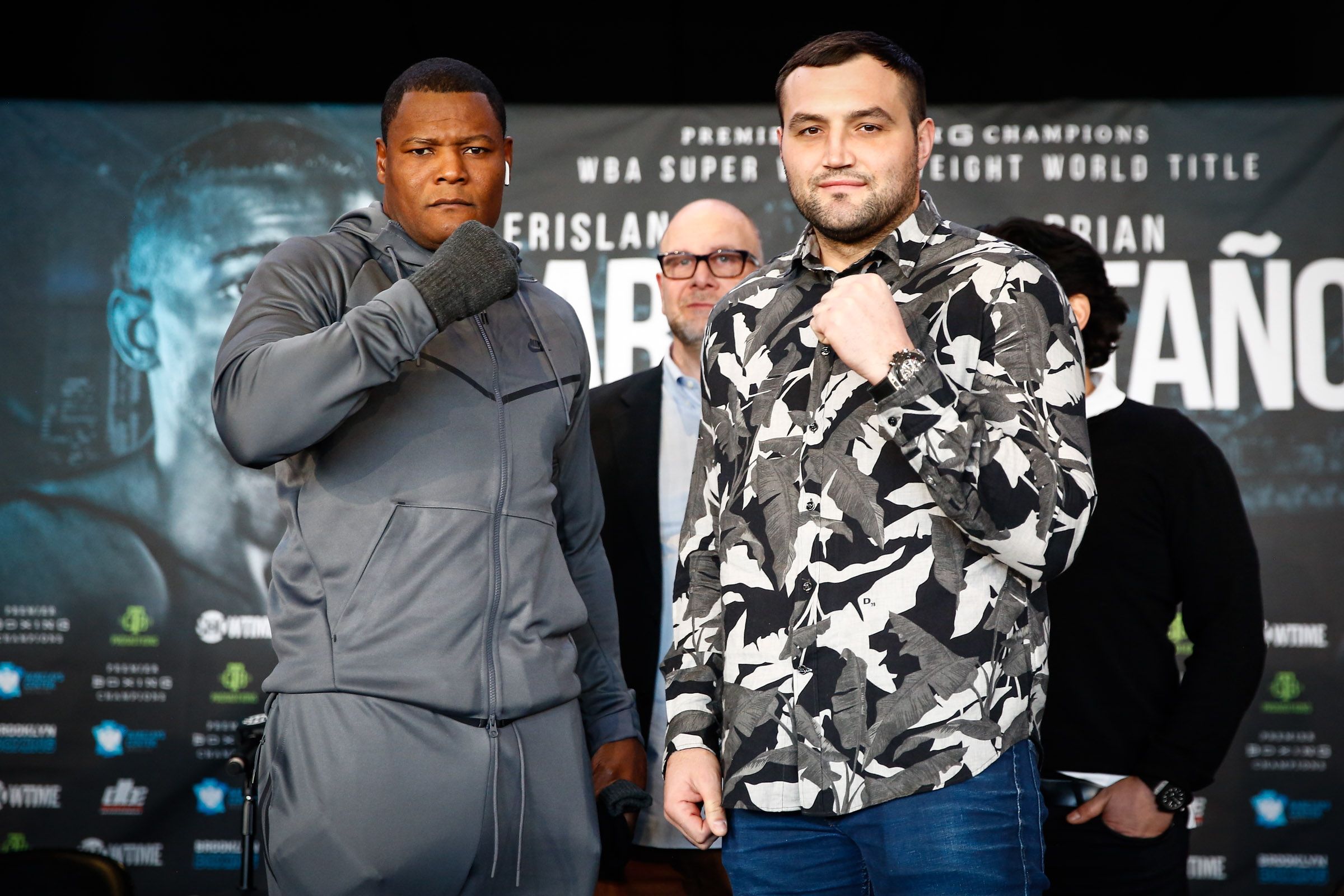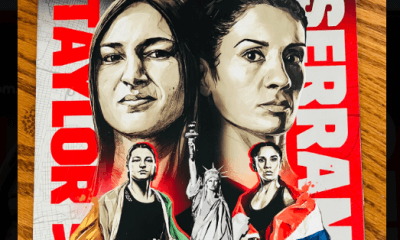Featured Articles
Avila Perspective, Chapter 36: Cubans, Claressa Shields and More

Smooth as a yard of silk, and slick as a pool of oil, best explains what boxing fans can expect to see when Cuban fighters Erislandy Lara and Luis Ortiz step in the ring for their respective battles this weekend.
Cuban style boxing represented at its best.
Not everyone prefers the wait-for-the-moment kind of fighting that Cubans employ, but if you do, then you are in for a treat. Both Lara and Ortiz excel in this boxing strategy.
Lara (25-3-2, 14 KOs) steps in the boxing ring against undefeated Brian Castano (15-0, 11 KOs) of Argentina for a version of the WBA super welterweight title on Saturday, March 2. A heavyweight co-main event features Ortiz versus Christian Hammer (pictured).
Showtime will televise the two fights from Barclays Center in Brooklyn, New York.
In his last fight Lara was run over by Jarrett Hurd nearly a year ago. The fight resulted in a split decision loss for the Cuban southpaw but many felt he legitimately was vanquished by the bigger and more aggressive fighter. This time Lara faces an aggressive but smaller Argentine slugger. It should be a perfect fit.
Like most Cubans taught that island style of boxing, Lara is a lefty who waits until you make a mistake then pounces on you. Patience is his weapon and nobody out-waits Lara. But if the opponent is aggressive, then the Cuban style can be a thing of beauty if utilized correctly.
“Saturday, it’ll be my time to take his belt,” said Lara at the media day on Wednesday. “Castano is undefeated but he hasn’t fought anyone yet. He’s definitely never fought anyone close to my level. After Saturday night, he won’t be undefeated anymore.”
Castano, 29, hails from Buenos Aires, Argentina and you never know what to expect from that boxing country. They can surprise you like Marcos Maidana did years ago in his big stage arrival.
“I’m very proud to be representing Argentina here at Barclays Center on a card of this magnitude on Showtime. I couldn’t be any happier because I know what this moment can represent to others. Its motivation that fighters from Argentina can make it to the highest level,” Castano said.
In the heavyweight clash another left-handed Cuban enters the fray.
Ortiz (30-1, 26 KOs) returns to the ring and faces Germany’s Christian Hammer (24-5, 14 KOs) in a 10-round heavyweight clash.
The big Cuban heavyweight still moves pretty well at age 39 and he has a foe standing in front of him who doesn’t like movement. But Hammer has fought guys like Alexander Povetkin and Tyson Fury so he has experience with top tier heavyweights.
“I take every fight against top fighters and I will fight them anywhere in the world. I want to be a champion, so I know I have to travel,” said Hammer. “I have to go in there and prove myself. I’m going to leave it all in the ring and show the best version of myself.”
Ortiz is a classic example of the Cuban style. He probes and punches judiciously and when he spots a mistake he takes advantage with lightning speed for his size and age. This is his moment to prove he still belongs with the top 10 heavyweights.
“I know he can go 12 rounds with a top fighter like he did with Alexander Povetkin, so we’re not taking any chances,” said Ortiz. “I’m not Povetkin though. So he’s not going the distance with me.”
If you like smooth style boxing this fight card is for you.
An uncle of mine that we call “Feo” Teo – he’s called Feo (ugly) because that’s what he calls everyone else – always boasts Cuban boxers are the best. He constantly brings up fighters like Jose Napoles, Sugar Ramos and Teofilo Stevenson. But you can’t believe everything he tells you. He also claims he’s the most handsome man in Southern California.
Claressa and Christina
Female prizefighting still has ground to make up in terms of recognition but if you are looking for a reason to watch the best, then make room on your calendar for the battle between undefeated middleweights Claressa Shields and Christina Hammer on April 13. Showtime will televise the event that takes place at the Boardwalk Hall in Atlantic City, New Jersey.
For those boxing fans that saw female boxing before and didn’t like it, well, all I can say is don’t base your opinions on the past. This is the present and these female prizefighters are a notch above anything in the past.
Hammer, 28, has that classic European style that most of the female boxers have. She boxes and moves while sticking out the jab and using her height and reach to out-point the opposition. She’s a strong girl who fights out of Germany and has been tested once in a fight against France’s Anne Sophie Mathis. That fight ended in a disqualification and a no contest after it was ruled Hammer was knocked out by an illegal punch. That was five years ago. Since then the tall German middleweight has pretty much had her way in beating American middleweights Kali Reis and Tori Nelson easily.
Shields, 23, has a totally different style from most female prizefighters. She’s like a dragster fueled by nitro, she explodes on the opposition. She can box, she can bang and she can out-talk anyone. But what most people don’t know is she’s a student of the boxing game. She knows boxing in and out. If you want to talk about Sugar Ray Robinson, Roberto Duran or James Toney that’s OK by her. She lives, sleeps and drinks boxing 24/7.
“I study tapes of old fights all the time,” said Shields.
How many females do you know that can talk boxing and know more than you?
As my uncle Feo would say “that’s heaven baby.”
Heavyweight Tantrums
A couple of days ago a Twitter battle between Showtime’s Stephen Espinoza and Matchroom Boxing’s Eddie Hearn took place over the revelation that a contract by representatives for WBC titlist Deontay Wilder was sent to multiple belt holder Anthony Joshua and allegedly refused, ignored or not seen.
The other heavyweight, Tyson Fury, recently signed a mega deal with Top Rank and ESPN that further muddied the heavyweight picture. Fury is considered the true lineal heavyweight world champion by many because he defeated Wladimir Klitschko when he held all the titles. But then he took time off because of personal issues and all hell broke loose. Now there are three heavyweights who all claim to be the real heavyweight champion of course.
Last December, at the Staples Center in L.A., both Fury and Wilder engaged in a roaring heavyweight battle that ended in a split draw after 12 raucous rounds. That didn’t answer any questions; it simply added more fuel to the fire. Now a rematch between the same two is on hold because Fury already has a date set up. But recently, it was announced that Fury does plan to meet with Wilder in September. We shall see.
First up to bat is Joshua who meets Jarrell “Big Baby” Miller at Madison Square Garden in New York City on June 1. DAZN will stream the heavyweight title fight card.
Danny “Baby-Face Assassin” Roman
From the moment he won the WBA super bantamweight title in Japan, the Los Angeles native Danny Roman has openly sought to unify all of the world titles in the 122-pound weight division.
Roman, 28, finally gets his wish.
On April 26, at the Inglewood Forum, Roman (26-2-1, 10 KOs) puts his WBA title on the line against Australia’s TJ Doheny (21-0, 15 KOs) a southpaw who has the IBF version. The unification bout will be streamed on DAZN.
“It will be a new experience for me because I’m not fighting a challenger, I’m fighting another belt holder. It’s exciting in a lot of ways. I’ll be at my best because I’m planning to add another title on April 26,” said Roman.
For those not familiar with Roman, he’s defended the title three times since dethroning Japan’s Shun Kubo in August 2017 by knockout. In every defense Roman has defeated opponents with at least four inches in height advantage. But when he meets Doheny he will be looking the Aussie dead-in-the-eye.
“Nothing is easy at this point. It’s going to be a heck of a fight,” said Roman. “Two World Champions fighting for control of the division. What more could you want?”
Fights to watch
Thurs. 6 p.m. UFC Fight Pass – Ray Ximenez (18-1) vs. Luis Alberto Lopez (16-1).
Fri. 11:30 p.m. Telemundo – Ricardo Franco (22-2) vs. Ricardo Nunez (29-8).
Sat. 3:30 p.m. PT YouTube.com/Showtime – undercard at Barclays Center
Sat. 6 p.m. Showtime – Erislandy Lara (25-3-2) vs. Brian Castano (15-0); Luis Ortiz (30-1) vs. Christian Hammer (24-5).
Photo credit: Stephanie Trapp / SHOWTIME
Check out more boxing news on video at The Boxing Channel
To comment on this story in The Fight Forum CLICK HERE
-

 Featured Articles4 weeks ago
Featured Articles4 weeks agoAvila Perspective, Chap. 330: Matchroom in New York plus the Latest on Canelo-Crawford
-

 Featured Articles3 weeks ago
Featured Articles3 weeks agoVito Mielnicki Jr Whitewashes Kamil Gardzielik Before the Home Folks in Newark
-

 Featured Articles17 hours ago
Featured Articles17 hours agoResults and Recaps from New York Where Taylor Edged Serrano Once Again
-

 Featured Articles4 weeks ago
Featured Articles4 weeks agoCatching Up with Clay Moyle Who Talks About His Massive Collection of Boxing Books
-

 Featured Articles5 days ago
Featured Articles5 days agoFrom a Sympathetic Figure to a Pariah: The Travails of Julio Cesar Chavez Jr
-

 Featured Articles3 weeks ago
Featured Articles3 weeks agoMore Medals for Hawaii’s Patricio Family at the USA Boxing Summer Festival
-

 Featured Articles7 days ago
Featured Articles7 days agoCatterall vs Eubank Ends Prematurely; Catterall Wins a Technical Decision
-

 Featured Articles4 weeks ago
Featured Articles4 weeks agoRichardson Hitchins Batters and Stops George Kambosos at Madison Square Garden




















